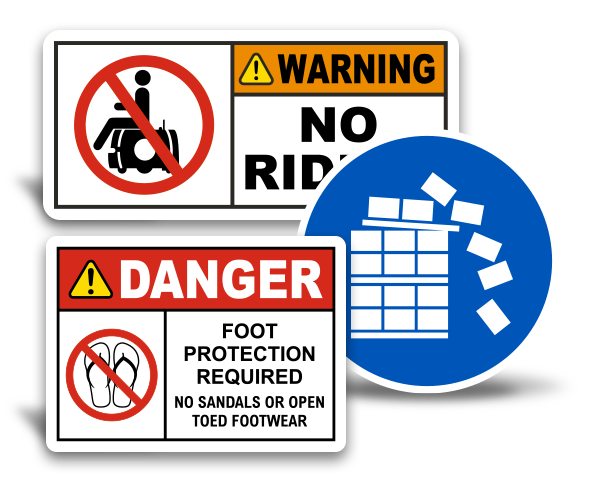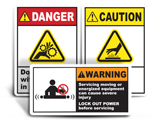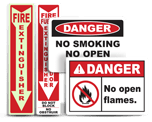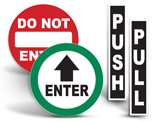ANSI Z535.4 Safety Labels
Looking for submittal information?
Download the Safety Label Information PDF (includes Submittal Sheet/ Material Info/ RoHS Compliance)
ANSI Z535.4 Safety Labels Construction
ANSI Z535.4 Product Safety Signs & Labels specifies performance requirements for the design, application, use and placement of safety labels and signs that are intended to identify hazards that a person may encounter while operating or servicing a variety of products.
ANSI Z535.4 Safety Labels Description
Adhesive Backed Polyester Labels have been designed to comply with ANSI Z535.4 2002 & 2007 Product Safety Label Standards. Labels are screen printed with UV resistant inks and over laminated with Clear Polyester to ensure a high degree of chemical, abrasion and heat resistance.
ANSI Z535.4 Safety Labels Material
2 Mil White Polyester with Hi-Performance pressure sensitive Acrylic Adhesive backing (UL® File No. MH10170 / CSA File No. 099241 L000) 1 Mil Clear Polyester film coated with a clear pressure sensitive acrylic adhesive (UL® File No. MH10170 / CSA File No. 099241 L000)
- Printed Image
- is sealed between 2 layers of polyester. Polyester offers superior chemical, abrasion and temperature resistance to vinyl labels, image is screen printed using UV resistant inks.
- Adhesive
- Aggressive solvent based acrylic adhesive with excellent adhesion properties on a broad base of application substrates such as Stainless Steel, Acrylic, Glass, Coated Metals and Plastics.
- Packaging
- All machinery safety decals are available in convenient packages of 5 or bulk packages of 50.
Safety Labels Compliance
- Most Machinery Safety Labels comply with ANSI Z535.4 2002 & 2007.
- Some Machinery Safety Labels comply with ISO 3864-2 2002.
- Some specific safety labels comply with CEMA.
- Arc Flash Labels comply with NFPA 70E.
Selecting the Right Safety Header
- Hazard Classification
- The first element to consider when designing or selecting a product safety label is to determine the likelihood and severity of a potential injury if a person does not follow the instructions contained on the safety label or sign.
There are four Signal Words or Hazard Classifications used in the design of an ANSI Z535.4 2007 compliant safety label: “DANGER”, “WARNING”, “CAUTION” and “NOTICE”
Click on this link to view Safety Labels: Header Classification
Safety Label Format
- Message Panel
- the message panel of any new ANSI Z535.4 2007 compliant sign or label must contain:
- Identification of the hazard,
- Identification of a means to avoid the hazard,
- And the consequences of not avoiding the hazard.
The order that the information appears in the message panel is flexible and should be determined by logical factors related to avoiding an injury, such as:
- The target audiences knowledge of the hazard,
- And the reaction time to avoid the hazard.
In addition, we recommend when formatting the message panel to consider the following practices:
- Use headline-style text
- Use active voice statements
- Avoid prepositional phrases
- Use left justification of the text except on one line messages
- Use upper and lower case letters
Click on this link to view & print: Brimar's Standard Label Sizes
Use of Safety Symbols
ANSI Z535.4 2002 encourages the use of safety symbols that communicate a comparable message to the worded message on the sign or label. The safety symbol when selected properly, should identify:
- The hazard,
- Identify a means of avoiding the hazard,
- Or identify the consequences of not avoiding the hazard. The safety symbol should clarify or reinforce the worded message on the label.
There are four types of safety symbols used on ANSI Z535.4 2002 compliant product safety labels. When using safety symbols to comply with ANSI, the symbol can be black on a white background, other colors may be used, like safety red for fire related symbols, and so on.
To comply with both ANSI Z535.4 and ISO 3864, then the following applies, ISO 3864 2002 standards required that all of the safety symbols used on international product safety labels be within a surrounding shape, a yellow equilateral triangle with black inner border for hazard alerting symbols, blue circle for mandatory actions, and red circle with 45° degree slash for prohibition symbols. ANSI Z535.4 2002 does not require the use of a yellow equilateral triangle or the mandatory surrounding shape but, it does recognize it and permits their use.
Symbol Classification: Hazard Alert Symbols
- Hazard Alerting
- This type of safety symbol conveys information primarily related to the nature of hazards. Like, hazard description, how to avoid the hazard and sometimes the consequences of not avoiding the hazard.
If a surround shape is desired, the hazard alerting symbol should be drawn within a yellow equilateral triangle. The yellow equilateral triangle is required on safety alert symbols used on ISO compliant product safety labels. The image below shows some examples from our Safety Symbol Database.
Symbol Classification: Prohibition Symbols
- Prohibition Symbols
- This type of safety symbol conveys actions that should not be taken. This symbol consists of a red circular band with a 45° diagonal red band from the upper left to lower right. The symbol contains a black image within the red band on a white background. Prohibition symbols are mandatory for use on ISO compliant product safety labels. The image below shows some examples from our Safety Symbol Database.
Symbol Classification: Mandatory Symbols
- Mandatory Action Symbols
- This type of safety symbol conveys actions that should be taken to avoid hazards. If a surround shape is desired, the symbol consist of a white image within a solid blue or black circular surround shape. The blue surround shape is required on ISO compliant product safety labels that contain mandatory action symbols. The image below shows some examples from our Safety Symbol Database.
Symbol Classification: Information Symbols
- Fire Related Safety Symbols
-
- Emergency Equipment Safety Symbols
-
Safety Label: Letter Size Legibility
Determining the safe viewing distance of a label depends upon many factors, including:
- Lighting, background, letter type and visual acuity.
Other factors to consider in determining label size, include:
- The complexity of the message, the reaction time necessary, and the angle the label will be seen from. In many situations, it is better to use multiple labels that are strategically positioned instead of one large one.
Many times letter size may need to be larger than the values shown on the graphic for a variety of reasons:
- To make the label more noticeable from other information displayed in the area.
- To enable legibility under low light, or other poor viewing conditions.
- To alert persons sooner than the minimum safe viewing distance.
- To convey special importance for portions of the message.
- To improve legibility for persons who have vision problems with small text.
Example of text message letter heights and *minimum safe viewing distances.
* Minimum safe viewing distance refers to the closest distance a person can be to the label and still have time to follow the safety label's message to avoid the hazard.Safety Label: Recommended Label Placement on Equipment
It is well recognized that in many instances, well designed and properly placed safety labels can increase operator and maintenance personnel awareness of the inherent hazards involved when working with machinery.
When installing labels on equipment we recommend keeping in mind the following criteria:
- Label needs to be readily visible to the target audience (personnel that may be in contact with the hazard)
- Label needs to alert the viewer to the hazard in time to take appropriate action.
- Labels are required to be applied on or adjacent to the area where the hazard is present.
- Labels are required to be permanently affixed to the equipment.
- Ensure that the surface to which the label(s) will be applied on is clean and free of dirt, dust, grease and moisture. If the surface is painted, ensure that the paint is dry.
- Press the label on after applying it to the surface. One or more passes over with a rag or roller will ensure that the label is completely glued on the surface and will not fall off.
SafetySign.com does not recommend or specify the use of a specific safety sign because it does not have knowledge of the hazard(s) our customers are identifying. It is the customer’s sole responsibility to identify the hazard(s) that may be present and select one or more signs (stock or custom) that accurately identify their specific hazard(s) and complies with any applicable federal, state or local laws or regulations, any worksite specific rules or regulations and/or any applicable safety standards (including, without limitation, ANSI and/or OSHA standards). SafetySign.com disclaims any and all liability (excluding liability for our Product Warranty contained in our Terms and Conditions) for any sign selected by a customer and shall not be responsible for any personal injury or property damage resulting from the use of signs purchased from it or for the independent interpretation made of any applicable federal, state or local laws or regulations, any worksite specific rules or regulations, and/or any applicable safety standards (including, without limitation, ANSI and/or OSHA standards). Customer shall indemnify and hold SafetySign.com and its corporate parent and its officers, directors and affiliates harmless from and against any and all claims, loss or expense (including attorneys’ fees) arising from or related to the purchase and use by customer or any third party of any sign purchased by customer from SafetySign.com.




















